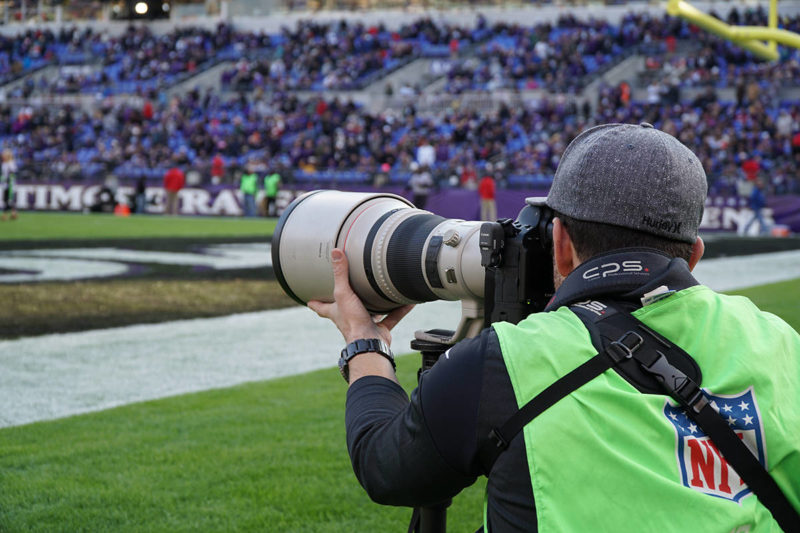From sharing photos in the moment on social media to adding the right image to a post on their website, strong visual storytelling is critical to the Baltimore Ravens digital media strategy.
“Our fans want to be in the moment with the players, and photography is a great way to be close to the players and get to know them,” says Ravens Digital Media Coordinator Erin Herbert.
The Ravens use PhotoShelter for Brands to make sure images are always at their fingertips. Watch the video to see the view from the field and the press box at M&T Bank Stadium and find out how the team uses PhotoShelter to power their visual communications across platforms.
Want to take a closer look at the Ravens’ workflow? Check out our webinar with Ravens Digital Media Coordinator Erin Herbert, How Winning It All Revamped The Baltimore Ravens Visual Storytelling Strategy.
15 Ways the Baltimore Ravens Use PhotoShelter for Brands to Streamline their Visual Asset Workflow
1. Everything in one place
The Ravens have five staff photographers – two who shoot game action, one who shoots the stadium, one who shoots the cheerleaders and another who shoots marketing events on game day at the stadium. After every home game, all five photographers send their final images to Erin via PhotoShelter so she can organize them and make them available for marketing materials, the website, social media and outside partners like media and corporate sponsors.
Later, when the team is searching for a photo, they only have to search one place, rather than bouncing around to different drives, servers and tools.
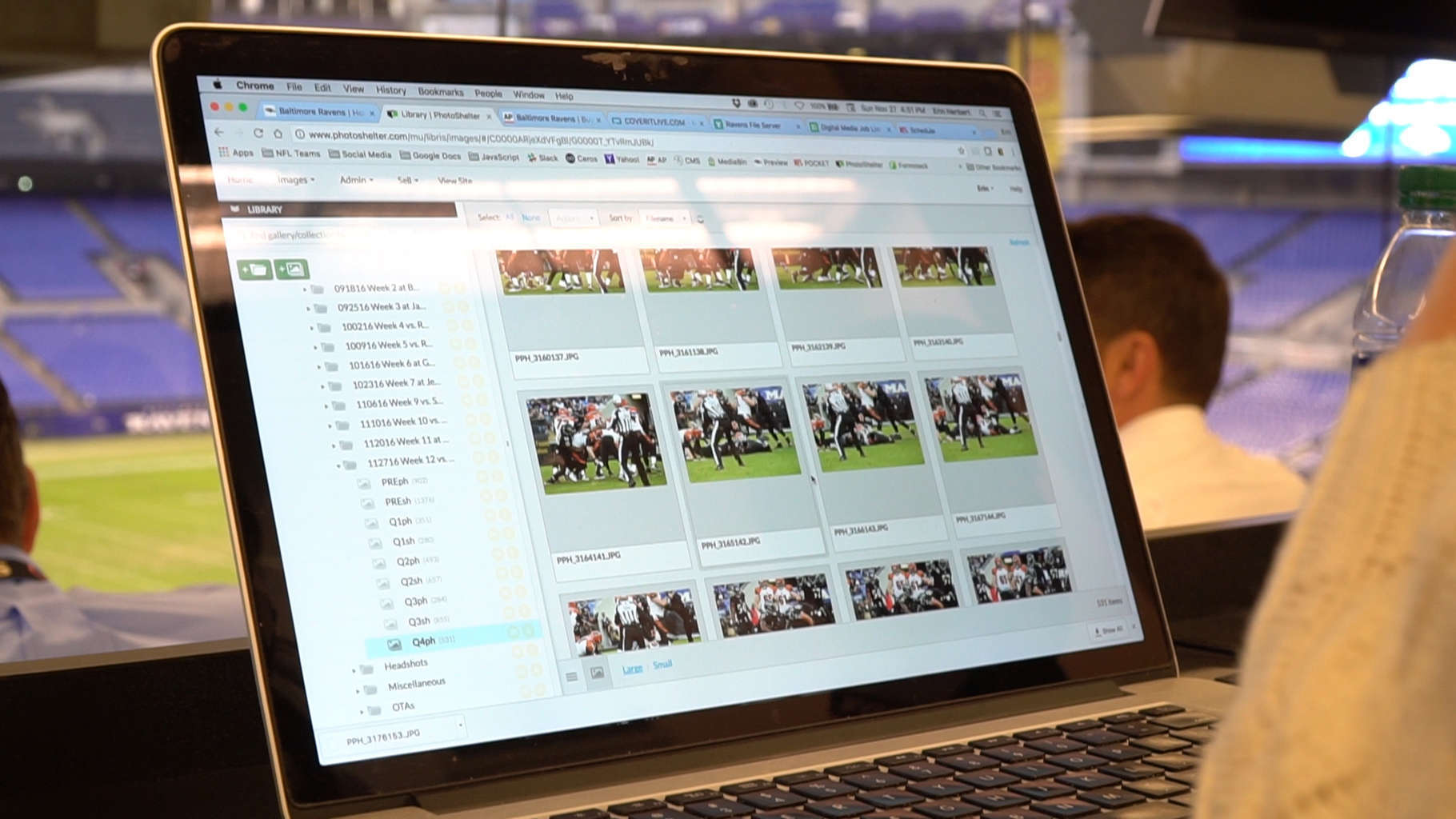
2. Easy access anywhere, anytime
Before the Ravens started using PhotoShelter, their photo database was only accessible inside the office. Not only was it getting more difficult to access photos from home and from the stadium, the problem came to a head when the Ravens secured a spot in Super Bowl XLVII.
When Erin left for New Orleans for the Big Game, she tried to predict what she would need and uploaded as many photos as she could to a hard drive to take with her. When she got there, she started getting requests from her own team members and from outside media for images they didn’t have with them. Before the game, she emailed her team members who were still in Baltimore for help, but when they arrived in New Orleans there was no one left in Baltimore to send her what she needed, so she had to tell reporters she didn’t have what they needed.
The frustrating situation led her to look into cloud-based visual media libraries. Now, she can access the Ravens’ entire archive, no matter where she is.
3. In-game image sharing
During the game, Erin and her team gather images from the Ravens game action photographers, Shawn Hubbard and Phil Hoffman. At the end of every quarter and at the end of pregame, they run down to the field to get their SD cards and bring them back up to the press box. They upload the content into PhotoShelter so different team members can access them to create photo galleries and put images out on social media during the game.
“For the fans that are not able to attend the game, we try to get photo galleries up on our website and social media as quick as possible so our fans can feel like they are present in the game and close to the game action,” says Erin. “For the fans that attended the game, once they leave the stadium, they can go on our website or social media and relive their game day experience.”
Football is family. #RavensFlock
: https://t.co/IzSB3vws77 pic.twitter.com/eCLnvTz5Hp
— Baltimore Ravens (@Ravens) November 27, 2016
4. Fast public relations
The Ravens PR team loves the quick send feature in PhotoShelter. When someone from the outside media requests a photo, a member of the PR staff just selects an image or two, hits “quick send” and sends it straight to the person’s inbox. No more need for DropBox or other online transfer services.
5. Away game workflow
Only one photographer travels with the team to an away game, unless it’s a big opponent game or a playoff game. Before they started using PhotoShelter, Erin would collect the cards from the photographer and upload them into an FTP so the team members at home could download them. But, with the FTP, they couldn’t see what they were downloading. They had to download the entire folder onto their desktops, then sift through all the photos. Now, they collect the cards and upload them directly into PhotoShelter so everyone can access them, preview them and download only what they need.
6. Powering a photo-first website
At the beginning of the 2016 season, the Ravens launched a revamped website that puts images in the spotlight. The team gets images from PhotoShelter for the homepage slider and every piece of content from post-game stories to interactive posts.
7. Quick search
The Ravens always include player names and opponents in the metadata of their photos because that’s what most of their searches require. In PhotoShelter, they can quickly run a search of “Joe Flacco” and “Steelers” and return all the photos of the quarterback playing his team’s rival.
On the back end, admin and editors like Erin can see all of the results:
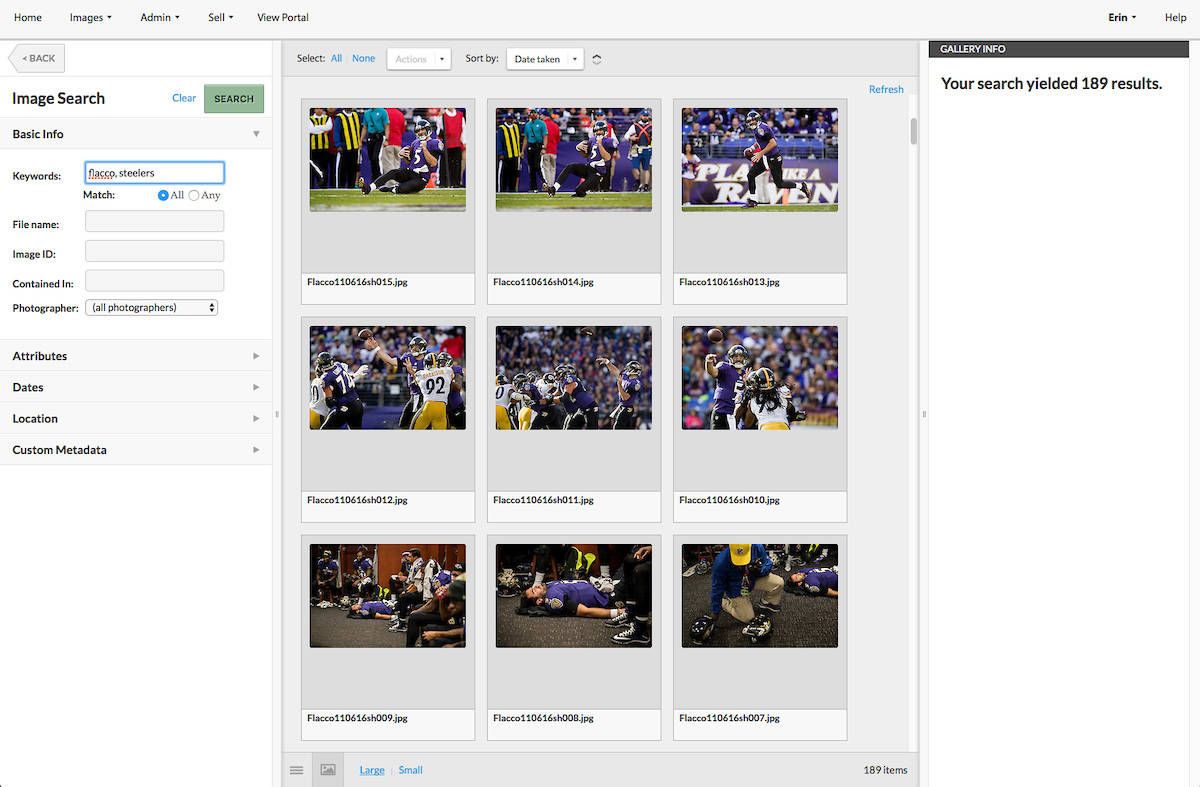
And on the front end, invited users can return only the photos Erin has given them permission to see:

8. Organization
The Ravens keep their photos organized with a collection and gallery structure divided up by games, events, sponsorship, etc. Within each collection, they create a gallery of final images from that specific event or game.
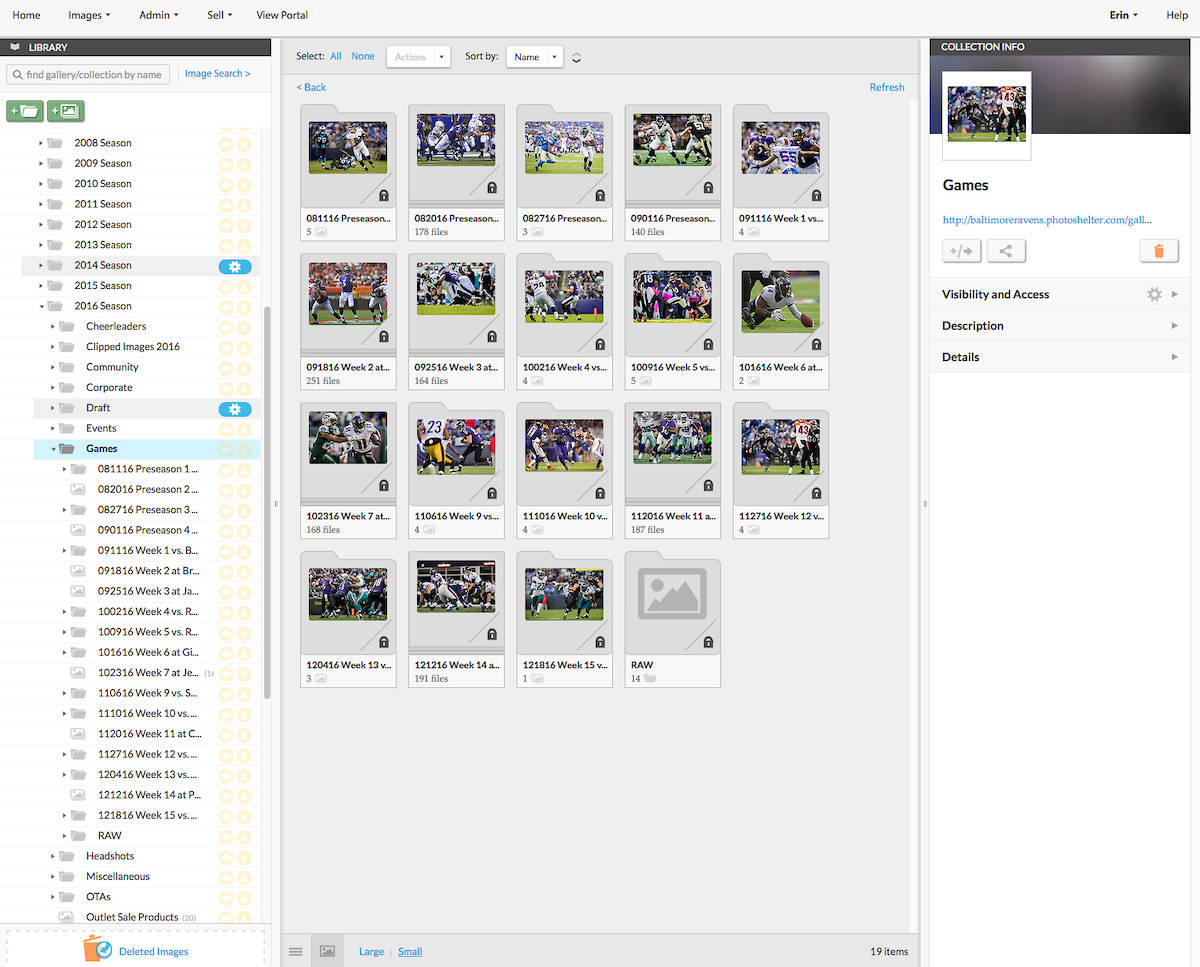
Bonus: During the game, the images are organized by quarter so the team can easily browse a gallery of just Q1 photos, just Q4 photos, etc. Later on, these raw images are deleted when they get the final edited shoots from the photographers.
9. Controlled permissions
Password protected galleries and gallery-by-gallery permissions settings let the Ravens control who can access their photos and who can’t. This helps their photographers rest assured their photos are being used responsibly and protects the images from being stolen or misused.
10. Logo storage
PhotoShelter also serves as the Ravens logo database. Now, everyone who needs high res logos and EPS files can find them in a flash.
11. Demonstrating impact to corporate sponsors
On home game days, one of the photographers shoots sponsorship in the stadium, like the Bud Light Party Zone or the Miller Lite Tavern. The Ravens sales team members review the photos after the game to find photos for corporate sponsors. They create a lightbox, then share it with Erin. She creates a password protected gallery, then sends them the link and the password. The sales team sends the gallery along to the sponsors so they can see their executions around the stadium.
12. Sponsored social media posts
Brands like Bose sponsor posts like this photo of the week. Most sponsored posts need a photo, so the digital media team searches PhotoShelter to find a photo to fit the post.
13. Throwback Thursday
Every week, the team shares a Throwback Thursday image on social media. Since the Ravens’ entire archive from 1996 up until now is stored on PhotoShelter, they can search a player’s name or an opponent and pull up a photo that fits perfectly with the upcoming game.
If legendary linebacker Ray Lewis is coming to M&T Bank Stadium for the upcoming game, they’ll share an iconic photo of Ray Lewis. If they’re taking on the Bengals, they’ll share a throwback photo of a past Bengals matchup. Here, they shared a snowy throwback before one of the coldest weekends so far this season.
14. Documenting history
Photographer Phil Hoffman considers it a key part of his job to document the careers of Ravens players. He strives to snap a photo of every player on the field at every game. He also captures important Ravens traditions, like the huddle before the game and the tunnel entrance.
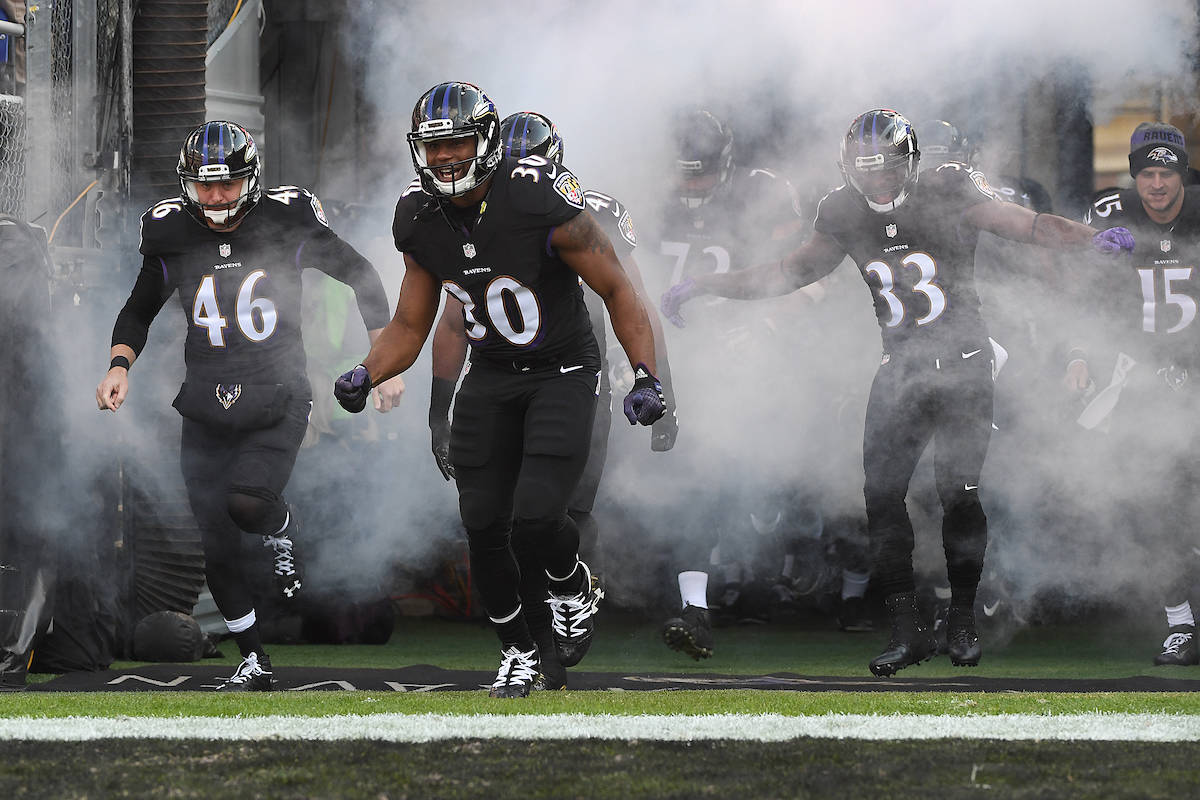
“I think it’s important to get photos of these important experiences to keep on file so we can go back and use them for content later in the future, and to also keep a record of it,” says Erin. “It’s really neat to see a team huddle from ten years ago that was led by Ray Lewis and then one from today that’s led by Terrell Suggs, and you still see the team camaraderie.”
15. Hall of Wins
After every Ravens win, five photos are pulled from PhotoShelter and the players vote for which photo was the most impactful. The winning photo goes into the Hall of Wins at the Under Armour training facility, alongside images from all of the Ravens wins since 1996.

The ROI of Visual Asset Management for the Baltimore Ravens
Erin estimates that PhotoShelter has impacted a quarter to a half of all Ravens staff members, as well as outside partners like media and corporate sponsors. The ripple effect of visual asset management is huge. With PhotoShelter, countless Ravens team members and partners can do more with their photos than they ever could before – an invaluable return on investment.
Super Bowl photos in video by Shawn Hubbard.
